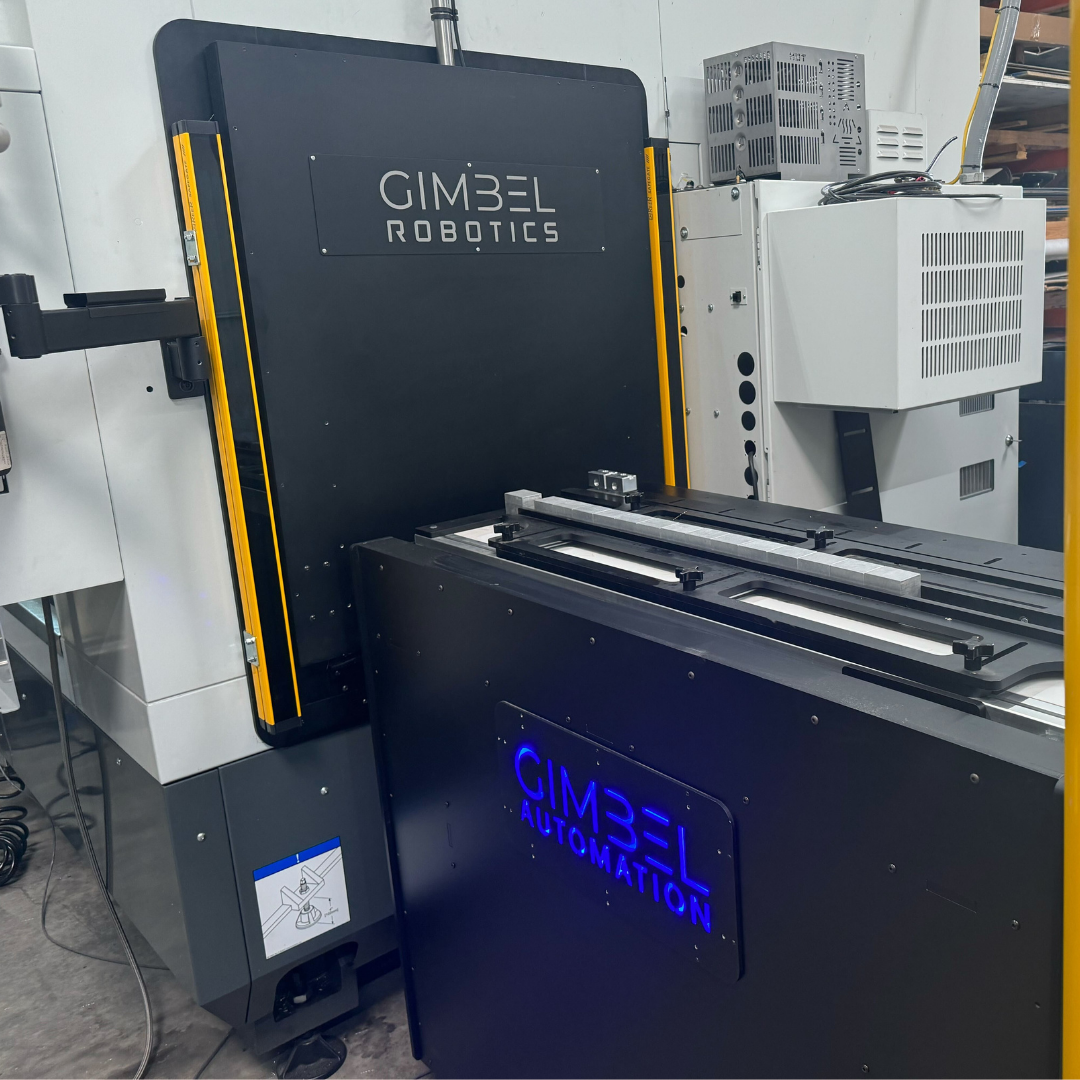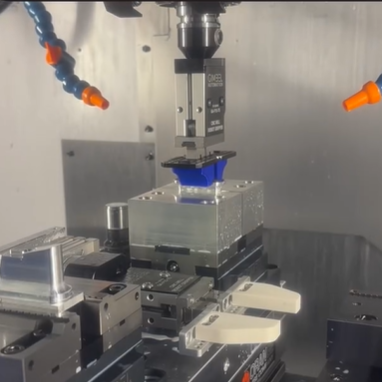Explore AI Summary
Introduction
Every machine shop and production floor has the dream of a smooth and automated production of their parts and products. But actually successfully implementing automated CNC Machine Tending for CNC Vertical Mills is usually an intimidating and expensive task.
There are also numerous different approaches to Automated CNC Machine Tending, including Automatic Pallet Loading, Pallet-Changing Robot Cells, Cobots, and CNC Spindle Gripping just to name a few. Depending on the type of parts and automation selected, CNC Machine Tending for vertical CNC Mills can range in price from $4,500 for One-Operation CNC Spindle Gripper System all the way up to $250,000 or more for a integrated pallet-changing or robot-cell system.
In this article, we'll discuss the various types of automation, and more specifically how CNC Spindle Gripper Automation can offer you unprecedented ROI compared to traditional CNC Machine Tending Automation Solutions.

Table of Contents
Is CNC Machine Tending right for me?
Why is CNC Machine Tending Important?
You probably want to invest in CNC Machine Tending if:
- You want to allow a single operator to run five or more machines instead of one
- You want to get the most out of your capital investment through “lights-out” production
- You’re having a hard time finding qualified and dedicated machine operators
- You want to minimize your labor costs and maximize your production
- You can’t keep up with your current production demands
- You have low Spindle-Utilization percentages because of long part-loading times
How Can CNC Tending Benefit Your Shop?
1. Boost Your Production Throughput
While many people outside the industry think that CNC Machine Tending will take away jobs, most people in the industry know that, in actuality, it’s quite difficult to keep up with demand. Moreover, to be profitable in North America as a Machine Shop or Production Facility, increasing labor and vendor costs are making it a necessity to have a single operator monitor and run three, four, or even five machines. This directly correlates to increased production output.

2. Boost Your Profits
In this industry, another difficult reality is that Monetary Capital is usually the biggest constraint: the CNC Machinery usually costs at least $75,000 per spindle. Getting the most out of that tied up capital on the shop floor also incentivizes companies to run two to three shifts, since it means that your spindle can be running 24 hours a day.
Because you are now making more parts with the same operators running multiple machines, and with the machines now running longer hours unattended, automation almost always leads to increased profits in the long-run. Gimbel’s approach to in-machine Automation can often result in ROI in as little as two weeks.

3. Better Allocate Your Labor Pool
Here’s something that you, a Machine Shop Owner or Production Floor Manager, already know: finding good people is hard. Finding great and reliable operators to work a job that involves loading and unloading parts all day is even harder.
That's why automation is critical to competing in the machining industry in North America. By leveraging one operator to run up to five machines, you can remain competitive, as well as allocate your talented staff where they're needed the most.

Do I Need CNC Machine Tending Automation?
You probably want to invest in CNC Machine Tending if:
- You want to allow a single operator to run five or more machines instead of one
- You want to get the most out of your capital investment through “lights-out” production
- You’re having a hard time finding qualified and dedicated machine operators
- You want to minimize your labor costs and maximize your production
- You can’t keep up with your current production demands
- You have low Spindle-Utilization percentages because of long part-loading times
What Are Some Other Reasons to Consider CNC Machine Tending Automation?
Improve Efficiency and Productivity
- Run Multiple Machines: Enable a single operator to oversee five or more machines, increasing productivity without expanding your workforce.
- Maximize Investment: Achieve optimal returns on your capital investment through “lights-out” production, allowing machines to operate autonomously even during off-hours.
Address Labor Challenges
- Overcome Labor Shortages: Struggling to find skilled machine operators? Automation can bridge this gap, ensuring continuous operation despite staffing challenges.
- Reduce Labor Costs: By minimizing the need for manual intervention, you can significantly lower labor costs and streamline your workforce.
Enhance Production Capabilities
- Meet Production Demands: If you’re struggling to keep up with current production requirements, automation can help scale your operations efficiently.
- Boost Spindle Utilization: Reduce long part-loading times that negatively impact spindle utilization, ensuring your machines run at peak performance.
There is no faster way to grow and increase profits than automation in the manufacturing industry.
Types of CNC Machine Tending Systems
1. CNC Spindle Gripper Machine Tending
CNC Spindle Gripping is one of the industry’s best-kept secrets for CNC Machine Tending. While it’s been used at the biggest companies including Kennametal, Parker Hannifin, and countless Tier 1 Automotive Suppliers, CNC Spindle Gripping has historically been unknown to small and midsized manufacturers.
CNC Spindle Gripper Automatic Machine Tending differs from other Machine Tending in its simplicity: rather than interface with an external robotic system, CNC Machine Tending uses the CNC Vertical Mill already on your shop floor as the Automation itself. It’s actually quite intuitive if you take a moment to think about it: your CNC Vertical Mill can already move in at least three-axes, so why not use that movement to handle the part-tending instead of an operator?
CNC Spindle Gripper Systems for Automated Machine Tending involve two key components: a CNC Spindle Gripper and a form of Automated Workholding. More advanced systems can also include a way to flip the component so that multiple operations can be completed in a single cycle. The system operates with the CNC Spindle Gripper being loaded into the machine spindle like any other tool from the tool-changer, and that Spindle Gripper than grabs onto a part from a tray affixed to the machine table or from a loading conveyor.

2. "Robot-in-a-Box" Machine-Tending Cells
Part-Loading Robot CNC Cells
Commonly referred to as a “Robot-in-a-Box”, Robot CNC Cells include systems from the likes of Automation Within Reach and many other systems that center around a robot from Fanuc, Universal Robots, or many other brands.
Pallet-Loading Robot CNC Cells
The key difference between Part-Loading and Pallet-Loading Robot Cells is exactly as you would assume: instead of exchanging individual parts, the Robot Cell is exchanging entire pallets consisting of one or more pieces of stock already in workholding. Examples of popular Pallet-Loading Robot Cells include Halter Robotics and Trinity Robotics.
The Pallet itself can be as large as the entire machine table, or as small as an individual Erowa or System 3R pallet that holds a singular component to be machined. These pallets almost always interface with an automated Zero-Point Pallet System that securely holds the entire pallet and allows the very precise and automatic location of the pallet for every single loading cycle.

3. Collaborative Robot (”Cobot”) Part-Loading
While there are many systems that use Fanuc or Kuka industrial robots in caged-off machine cells, the innovation of Collaborative Robots has enabled Cobots to see more and more use in machine shops and Production Floors across the United States.
While it usually doesn’t make sense to Pallet-Load using Cobots, Part-Loading with them can be an excellent solution for many shops. Since they don’t need safety cages or light-curtains to prevent workplace accidents, the robot can be setup to load and unload individual pieces of stock.
The biggest downside of cobots include the initial system cost and the difficulty of implementation. While the robots are supposed to be easy to “train”, it is still an extra step to be carried out for each and every different part that you want to automate. In reality, Cobot integration is almost never as easy as it seems, and the vast majority of shop floors opt to hire a Systems Integrator to work out the details and integrate the system for them.
A good rule of thumb for a mid-tier Cobot Integration is to spend $50,000-$75,000 on the Cobot and peripherals, and to budget $35,000-$50,000 for the System Integration process.

More About spindle gripper cnc automation
Components of CNC Spindle Gripper Systems
1. The CNC Spindle Gripper
The CNC Spindle Gripper is an automation tool for CNC Machine Tending that loads into the machine spindle like any other tool. It can grab and release parts, and changes in the machines automatic tool-changer (ATC).
2. Automated Workholding
Of course, you need a way to hold your parts during the machining process, so you'll need to use an automated vise.
3. Accessories & Advanced Features
For more advanced customers, products like our Part Flip Station or our Two-Operation Automation Pallet can allow complete single-piece flow and automated production.
How It Works: CNC Spindle Gripper Machine Tending
The gripped part is placed into the automated vise, and the parts is then machined in-place. Once the part is finished its first operation, it is either put back in the tray or loading conveyor’s outfeed, or continues automatically to be regripped, flipped, and automatically machined for any other ops.
There are two key advantages to CNC Spindle Gripping over other CNC Machine Tending automation solutions:
- CNC Spindle Gripper systems are extremely cost-effective. A typical One-Operation package can be purchased for less than $5,000, and a typical Two-Operation package can be purchased for less than $10,000. This results in extremely fast return-on-investment.
- CNC Spindle Gripper Automation is by far the easiest Machine Tending system to implement. Since the programming and math is done exclusively on your CNC machine’s existing control, there is no robot to train, no complex hardware to integrate, and no overhaul of your existing programming workflow.
































